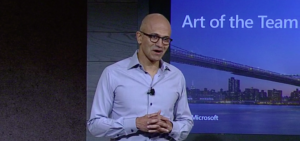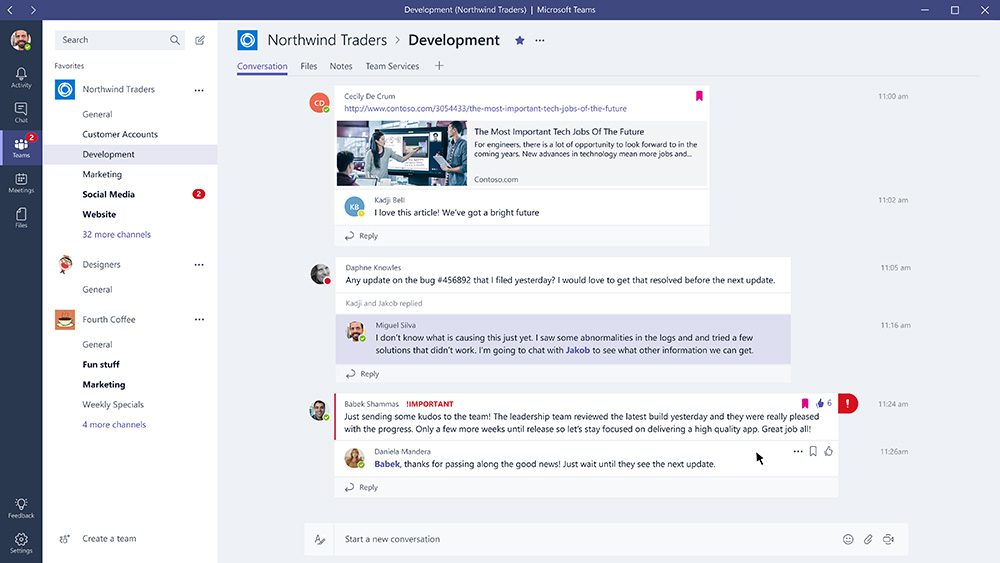Yesterday Microsoft responded to the incredible rise of Slack, the cool “new kid on the block” inter office chat app, with Teams. I watched the live stream of the announcement and was surprised. I expected a Slack alternative, a “Slack killer” even, but what they’ve announced is much more significant. Teams and Slack together signpost the future of collaboration and the evolution of the digital workplace. The collaboration and enterprise social network software providers need to take notice.
Over on Hewlett Packard Enterprise Insights, their enterprise.nxt guide to digital transformation, they published my post “5 things Slack and Microsoft Teams tell us about workplace collaboration”. This is a companion piece, amplifying those conclusions having had a chance to think through the implications of what I saw streamed from yesterday’s Microsoft NYC Office event.
 Earlier in the year it had been rumoured that Microsoft might buy Slack for $8Bn, but they’ve done their own thing instead. Yesterday’s announcement was an open secret for a while, and Slack took the rather interesting step of publishing a full page advert in the New York Times, simultaneously publishing the text on Medium. They say they are excited at the competition, but that’s more in the context of the purported Chinese curse “May you live in interesting times”.
Earlier in the year it had been rumoured that Microsoft might buy Slack for $8Bn, but they’ve done their own thing instead. Yesterday’s announcement was an open secret for a while, and Slack took the rather interesting step of publishing a full page advert in the New York Times, simultaneously publishing the text on Medium. They say they are excited at the competition, but that’s more in the context of the purported Chinese curse “May you live in interesting times”.
First let’s run through what Slack have achieved, which is pretty incredible really! They’ve only been around since August 2013. You probably didn’t know that the name is an acronym, “Searchable Log of All Conversation and Knowledge”. Slack has $540m in funding and a valuation of around $3.8 billion at their last funding round in March, and then we had those Microsoft rumours. Back in May this year Slack passed 3m daily active users, but that was 3.5 times growth in both free and paid for users over the previous year, and the rate isn’t slowing down (so even with Microsoft’s announcement, Slack won’t be going away). As I explained in the HPE article, Slack is used by 77 of the Fortune100. There are teams inside eBay, Ogilvy, Salesforce, Samsung, and Urban Outfitters. IBM themselves have 30,000 users, and have even announced a partnership with Slack so Watson’s AI can quickly provide insights from the huge data sets collected by the messaging system. Slack is being used by large enterprises, small enterprises, by groups of developers sharing code snippets, and it’s even gaining traction in the gaming community.
Like so many web based products of recent years that we know and love, such as Twitter or Flickr, it is the result of a company doing a pivot from their original intention. Stewart Butterfield and his team were working on an online game called Glitch. They had developed their own internal messaging system, and when the online game didn’t succeed, they launched their internal collaboration solution instead, to become the cool product platform that it is now. They have the classic freemium business which has made it easy for groups of users, frustrated with whatever collaboration options they have within their enterprise, to set a Slack group, invite people in and provide their own tactical solution to help a particular community, issue or project. There are plenty of other options around like HipChat in the business world, or Discord in the gaming community, but in a very crowded market of overalapping communication tools, Slack have made a big impact inside 3 years.
Let’s look at what Slack actually provides a group of users. The functionality covers three areas:
- A message threading alternative to email that is device independent. I can use it on Mac, Windows PC, through a web interface, or with mobile apps for smartphones and tablets. Conversations are synced across all devices so I can join the conversation in one place, and continue on a different device when I’m on the move or back at the office.
- It has a more open communication approach – the conversations get organised within channels that are like the hashtags I’m used to on public social media platforms, and everything is searchable so that I can easily loop in the skills and people I need.
- The third key area is Slack’s focus on helping me with menial tasks. They have a growing directory with over 750 apps, chatbots and algorithms that I can deploy to help make my collaboration life that little bit easier. Slack are riding the growing wave of Bots, Machine Learning, Artificial Intelligence and Robotic Process Automation – a mega trend that is changing office work just as much as automation has on the shop floor.
But wait, there’s more. I mentioned sharing code snippets, but those 750 apps include easy integration with developer and agency friendly tools like Trello, IFTTT, Zapier and GitHub. They are also investing in people to help them scale with senior hires from Salesforce and Foursquare this year.
Slack’s success highlights a key problem for our existing collaboration software options. They are more difficult to use than they should be. On top of that, the digital workplace is a mess. Alongside whatever we use for team collaboration, we access a whole host of disparate corporate systems with differing interfaces to get the job done. Slack has the ease of use and frictionless set up of the consumer apps we all used to on our smartphones and tablets. On top of the user experience there are two more factors. First, team chat functionality which allows me to find, connect and communicate with the right experts helps me get the job done. It’s a core component of all the administration and knowledge work we do. Second, and the masterstroke, is the open platform which provides the store of bots and integrations to third party apps. It means Slack (or Teams) provides me with a place where work happens. Where I can connect to these disparate app silos that my company uses, but in one place where the useful conversations are already happening. This is the starting point for a proper digital workplace, or what Dion Hinchcliffe called a digital workplace hub in his post on ZDNet a few days ago.
More than anything with this team chat based digital workplace approach, I’m looking forward to the demise of email, and products like Slack and Teams bring that a little closer. Having discussed the incredible rise of Slack, the functionality it provides, and some of the reasons why it’s been successful, what did Microsoft give us in response?
Yesterday, CEO Satya Nadella and Office Corporate VP Kirk Koenigsbauer, with a little help from their friends, laid out the new strategy and provided an impressive demo of Microsoft Teams. From my initial take it has many of the good characteristics of Slack, certainly has a similar look and feel, but offers the potential of more through tight integration with the Office365 family of products that it sits in, and becomes the front end to. Satya opened the announcement talking about how the new product needs to accomodate how different teams work differently, using the example of jazz ensembles, crew races, and even cricket teams, and that sets up the fact that the product allows you to customise the experience on a team by team basis.
Getting in to the demo helps explain what Teams does. Over on the left of the screen there are tabs for activity, chat, teams, meetings and files. This bar moves to the bottom in the mobile experience. When you set up a private team, a Sharepoint is automatically provisioned “behind” it to support it, and so any files are put there or created there. The team space showed normal multithreaded conversations, and I rather liked the way messages to you were highlighted with a red tab/tag over on the right of the message. You can open files or notes within the stream, and have conversations around them. Of course (the rather excellent) OneNote has all the characteristics of a wiki for co-creation. When you go in to a team space, you can pin things on to the tabs across the top of the space. Things like the budget for this project (an Excel spreadsheet), a planner for this project team, or even third party tools like Zendesk, accessed right there. This access to, and seamless integration with, the whole of the Office365 suite, or things like Microsoft Power BI, and on top of that a set of third party apps too, is crucial. Teams acts like your inbox, or maybe it’s a workbox, or maybe it’s your digital workplace hub.
When it comes to typing your messages you can add emojis, stickers, or attach files. A ‘Fun Picker’ lets you find and add Giphy GIFs, or memes. The next thing to say is that you can interact with bots just like in Slack. T-Bot sits on top of Teams’ help system, so you can ask questions like “how do I create a channel?”. WhoBot links in to the directories, and more importantly the conversations and meta data associated with that person, so you can ask “who knows about ticket sales?”. You can jump in to video chat with the team right there, using Skype.
Microsoft Teams is available now as a customer preview in 181 countries and 18 languages. General Availability is planned for Q1 2017, when it will have 85 Bots, 70 connectors, and integrations with 150 partners including Zendesk and HootSuite. In terms of licensing it is available to any user on an O365 Enterprise or Small Business plan. One key point that Satya emphasised is that Microsoft already have 85million active users of O365, and this is the market they are addressing.
Microsoft Teams looks like a very good team chat option, but it has important advantages if you are already following an Office 365 strategy. Both Slack and Teams bring you to a place where you can connect and collaborate with overlapping teams to get things done. They both plug in to the rising trend of bots and AI to automate tasks, find answers quickly and easily, and save time. They both offer an array of integrations with other business apps and so begin to provide a practical answer to Dion’s digital workplace hub. They definitely point the way for the next stage of collaboration solutions, and the major social software players need to take note.
Find out more about this year’s Enterprise Digital Summit London:



